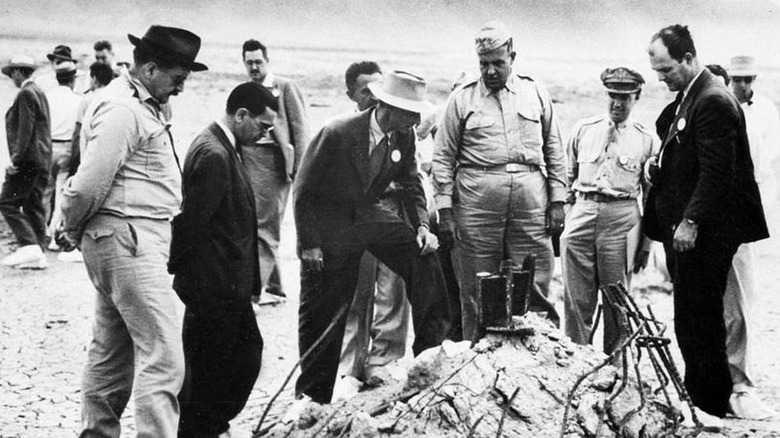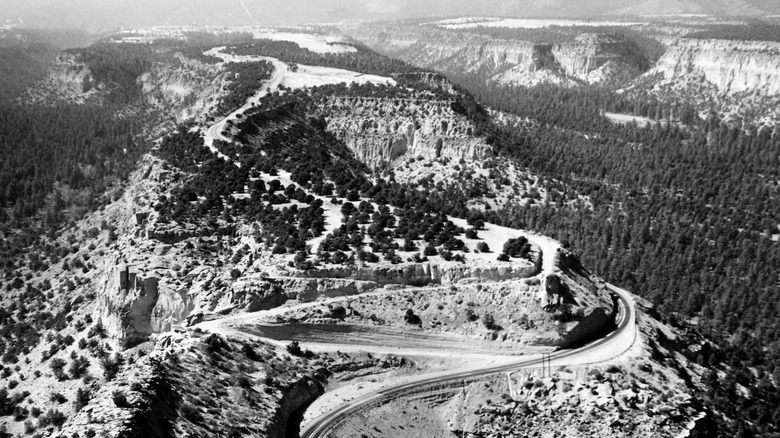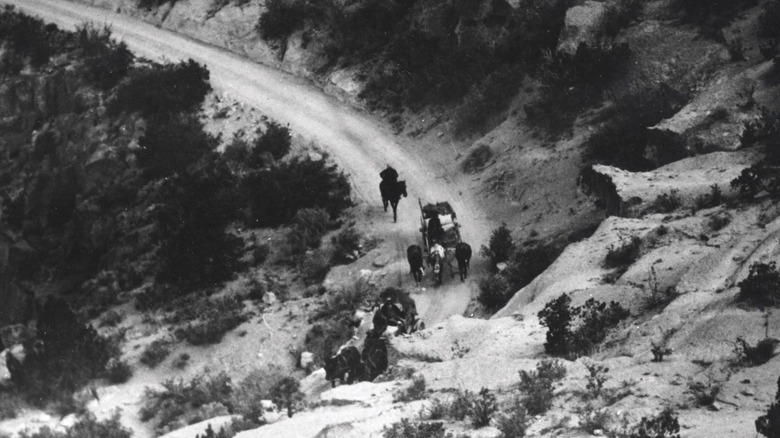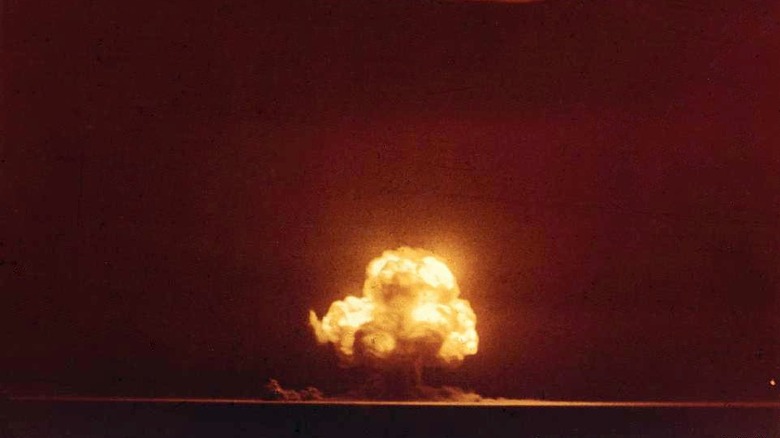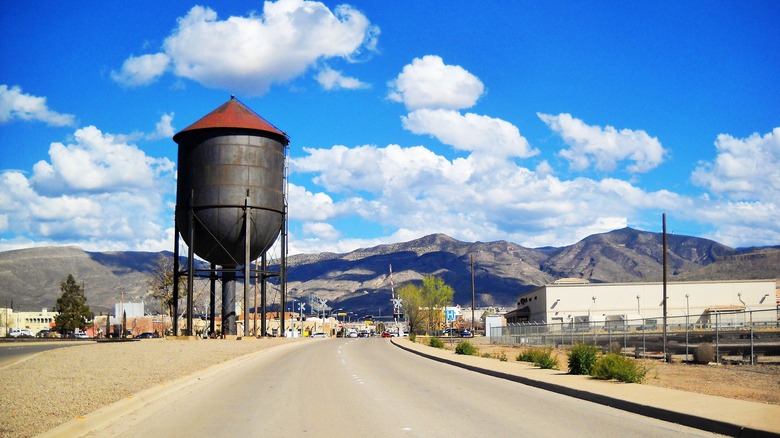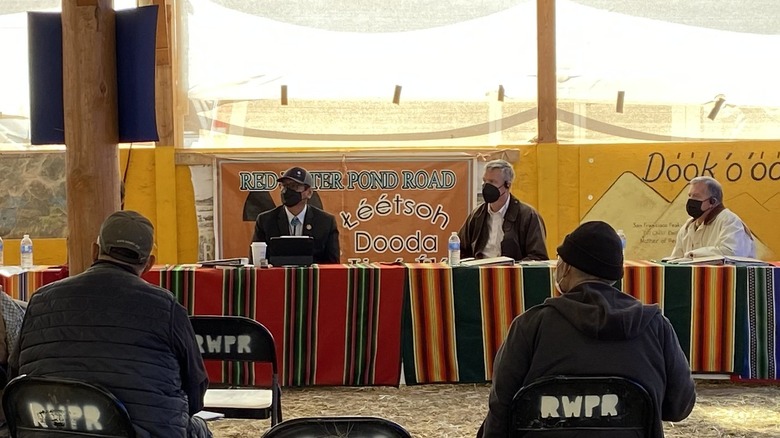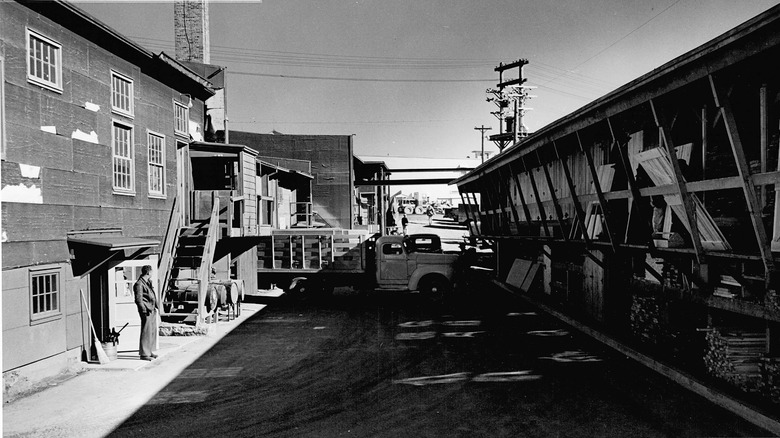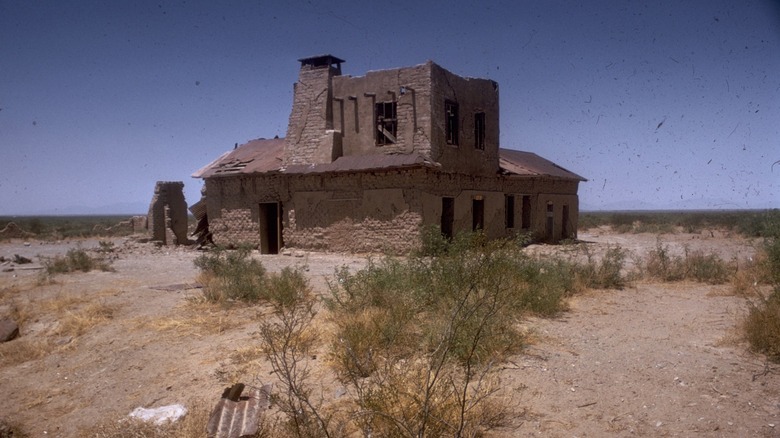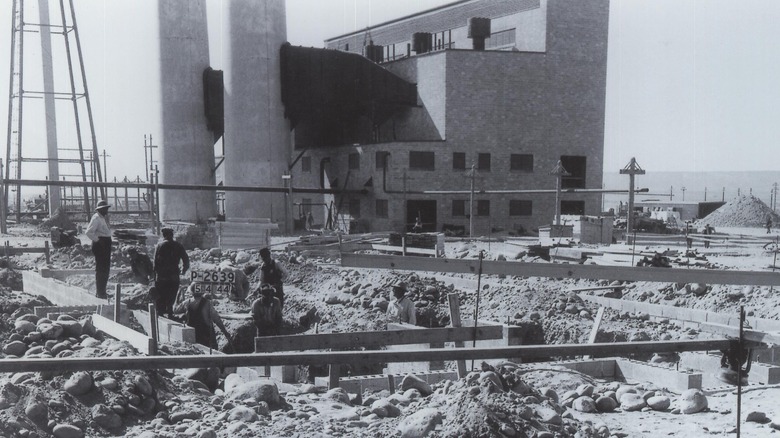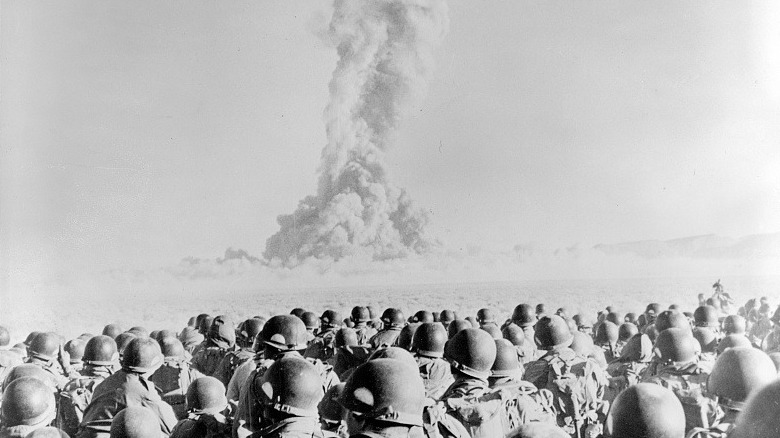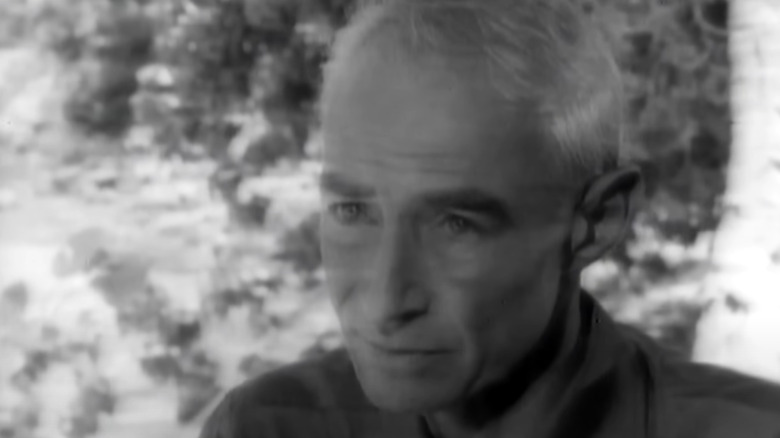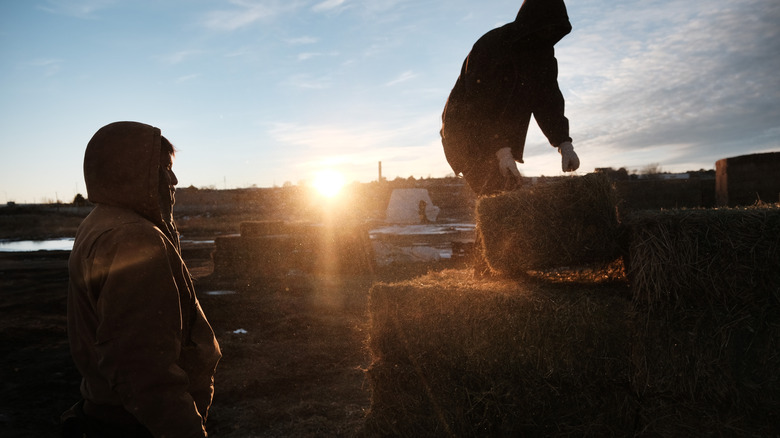The Dark Truth Oppenheimer Left Out About Hispano And Native American Communities In New Mexico
In the race to develop nuclear weapons, the U.S.A. poisoned its own people, and many have still not received compensation or even recognition for the fact. This is the message from the Union of Concerned Scientists (via the LA Times), who are working to raise awareness about the overlooked victims of nuclear weapons testing on American soil. Nuclear weapons are one of the most shocking and terrifying things humanity has ever created, but their damage extends far beyond their use during World War II.
J. Robert Oppenheimer, physicist and the first director of Los Alamos National Laboratory, is famous for uttering the line, "Now I Am Become Death, the Destroyer of Worlds." He was paraphrasing a Hindu sacred text, the Bhagavad Gita, and a line that was on his mind while watching the Trinity Test, the world's first nuclear detonation. The name Trinity came from one of Oppenheimer's other literary influences, the poet John Donne, famous for his meditations on mortality and the fragility of life. Clearly, the terrible reality of the destruction that would result from Oppenheimer's work was well apparent to him. While the unbridled violence of the atom bomb stunned the world though, much of the death and suffering caused by nuclear weapons has been consistently swept under the rug of history. While they were still being developed and tested in New Mexico, people's lives were upended and ruined, and those who were hit hardest were impoverished Hispanos and Native Americans.
Life in the desert of death
The site for the Trinity nuclear test wasn't chosen purely on a whim. Thought went into choosing a site with the right geography, with flat ground in an area that usually had little wind. Per the National Museum of Nuclear Science and History, it's in a desert region known as Jornada del Muerto, a name which roughly translates as "Route of the Dead." A chillingly appropriate name, given what was to come.
The same careful consideration was not afforded to people living in the surrounding area. While the official story is that the desert was mostly uninhabited, in reality there were numerous people who called the place their home, and the site was close to several small towns containing thousands of people. Many were Hispanos, a New Mexico local term for people of Spanish and Mexican descent. Some had been there for generations, with Hispanic communities in the area going back almost half a millennium, ever since the Spanish first arrived in 1541.
A history far longer belongs to the nearby Native American communities, who have also often been overlooked. New Mexico is home to 19 Pueblo peoples, three Apache tribes, and the Navajo Nation. Many have historically lived in the nearby Tularosa Basin, which has been inhabited for millennia, long predating both Spanish colonization and the later formation of reservations. The area surrounding the detonation site still has a sizeable Indigenous population, with several Pueblo communities and a Mescalero Apache reservation.
The locals evicted by the military
The U.S. Military was fully aware that there were civilians living in the area, as was Oppenheimer himself. They used the power of eminent domain to seize the land from those who were living on it, setting up a base camp and observation bunkers for the nuclear test. When the military started making preparations for the Trinity test, several homesteads in the area were still owned by their original occupants or their families. The official word is that the occupants were fairly paid for their land, but the first-hand accounts tell a different story.
Some Hispano families said they were forced out of their homes at gunpoint. Those who did receive money for their property received substantially less than nearby white landowners. A ranch run by an Anglo entrepreneur was bought for $43 per acre of land, while Hispano homesteaders were paid as little as $7 per acre for theirs. The evictions that followed were swift and forceful. People whose families had lived on the same land for centuries suddenly found themselves homeless, with nowhere to go and no more possessions than those they could carry. In the space of a single day, they found themselves ruined and with nowhere to go, owning no more than they could carry; the military gave many just 24 hours to leave before their farms were bulldozed and their livestock were executed.
The world's first nuclear detonation
On July 16, 1945, in the desert of New Mexico, America detonated the world's first atomic bomb in an 18.6-kiloton explosion that released a wave of searing heat, melting the nearby sand and asphalt into green glass. The surrounding area was full of families and communities, most of them Native and Hispano Americans, living perilously nearby. None had any idea of what was about to happen. No one was warned about the nuclear test or the potential dangers of radioactive material in the air. At dawn, many were woken by a thunderous explosion and a light both brighter and hotter than the desert sun; the light from the test could be seen from the cities of Albuquerque and El Paso. A handwritten account from a local man, Henry Herrera, mentions that it felt like the end of the world (via Trinity Downwinders).
The weather conditions that day had been poor, and those involved in the Manhattan Project knew it. Storm winds threatened to disperse radioactive material over a wide area, prompting Italian physicist Enrico Fermi to personally warn Oppenheimer about this. Fermi's advice went unheeded and radioactive ash rained down on nearby homes. Within 10 days, fallout had reached most parts of North America, finding its way to 46 U.S. states, as well as Canada and Mexico. Unknown until relatively recently, it's clear the military vastly underestimated the bomb's effects. It's hard to say with certainty what the full impact of the Trinity test was.
The fallout
In the 1940s, most people in New Mexico lived in rural communities, and a significant percentage of them were Hispano. After all, New Mexico had been part of old Mexico just a century earlier. Numerous people lived in the Tularosa Basin near the Trinity test site, and they'd later become known as "downwinders." The U.S. Military had prioritized secrecy and, despite concerns that some people may need to be evacuated following the detonation, they took no action. All those downwind of the site unwittingly found themselves living on contaminated land.
The land on the test site was officially considered unsafe for a full 20 years after the detonation, but no official warnings were given. Per Axios, some curious locals even visited ground zero themselves, having picnics and collecting pieces of the green radioactive glass left behind in the desert. Even after atomic bombs struck Japan and showed the world the weapons America had created, many residents of New Mexico didn't understand what was happening as they started to develop rare cancers and struggled to receive the medical attention they needed. Ultimately, the military kept the land they'd taken: In the present day, the Trinity site is part of the White Sands Missile Range, closed to the public except on a couple of days each year when visitors are permitted.
[Featured image by Foreverstocks via Wikimedia Commons | Cropped and scaled | CC BY-SA 4.0]
The forgotten Navajo miners
Another often untold side to the story of the Manhattan Project is the effect on the nearby Navajo Nation. The entire operation of the Manhattan Project relied on uranium, and all the uranium was mined by Navajo workers. They too, would soon find themselves developing cancers they couldn't explain, and many were faced with healthcare bills they struggled to afford.
For half a century, from the Manhattan Project until the 1990s, the U.S. leaned heavily on the Navajo to supply uranium. It was essential for both nuclear energy and weapons. However, as Time explains, while those in charge were well aware of the risks involved in mining radioactive material, the workers were kept in the dark. The Navajo were given no warnings about the dangers of what they were digging for, and no help was given to clean up the mining sites after they were shut down. The Navajo Nation is littered with over 500 disused mines, with people still raising their families in contaminated areas.
Even now, disused uranium mines on Navajo land still contaminate tribal waterways with toxic heavy metals. Not just uranium, but also poisons like lead and arsenic. Navajo people still face hardships because of the legacy of uranium extraction, with high rates of health issues like cancers and kidney failure. To this day, the Navajo Nation has received neither compensation nor justice.
[Featured image by Nuclear Regulatory Commission via Flickr/NRC | Cropped and scaled | CC BY 2.0]
Los Alamos National Laboratory's dark Hispano heritage
The Los Alamos National Laboratory (LANL) is one of the world's most famous institutions for studying nuclear physics, established in 1943 for the express purpose of working on the Manhattan Project to develop nuclear weapons. For its part, the laboratory acknowledges that it owes much of its history to local Hispano people, mentioning how they were hired for a variety of jobs, even while facing discrimination. In the official story, however, the laboratory omits some dark details.
As journalist Alisa Lynn Valdés explains in a Twitter thread, Hispanos had been evicted from their homes for the Trinity test and were left with nothing. With nowhere to go, all of the men displaced by the nuclear test found themselves working for the very laboratory that had ordered their evictions. There they were employed under Oppenheimer to work with beryllium, a metal essential for creating nuclear reactors and manufacturing the plutonium used in the Trinity test. Unfortunately, beryllium is also toxic: Acute exposure can cause dermatitis, pneumonia, and pulmonary disease, while chronic exposure can cause lung, liver, and kidney problems, per StatPearls. While the white workers were given protective equipment to wear, the Hispano men were not, and every one of them ended up dying of berylliosis.
Life in the world's first fallout zone
Nuclear fallout was poorly understood when the Manhattan Project detonated its first atomic bomb, but the military took no precautions to protect the nearby Hispano and Native American communities. No residents were evacuated, and none were even warned about the risks of the radioactive ash that had fallen on their homes. The International Campaign to Abolish Nuclear Weapons recounts the grim details of the downwinders' ordeal. Ionizing radiation has the most severe effects on human cells which are rapidly developing, so the worst damage is suffered during pregnancy and in children. Within months, the infant mortality rate soared by 56%, mostly caused by rare birth defects. Authorities were alerted to what was happening, but they took no action.
Next, cancer rates began to rise to alarming levels. Gloria Herrera, a Tularosa local, reported 285 people she knew dying from cancer since the Trinity explosion. As well as unusual forms of cancer, people fell ill with heart disease and leukemia, and the effects were compounded by the fact that many had trouble accessing healthcare — not only was it too expensive for some to afford, but there were no local healthcare providers, meaning long journeys were needed to see doctors. As a final insult, the radioactive material caused damage to people's chromosomes. This means that not only are the effects long-lasting, but they can also be passed down through family lines. Generations later, the families of downwinders still have high rates of cancer.
Loyda Martinez: A forgotten whistleblower
Oppenheimer was well aware that the military had evicted people to make way for the Trinity test. One of those evicted, though, would become an important figure among the Hispano ranchers displaced by the Manhattan Project's tests. According to journalist Alisa Lynn Valdés, Loyda Martinez went on to work at Los Alamos National Laboratory as the others did. Her father was one of the men who died from beryllium exposure, but she managed to get herself into a position to get justice.
Martinez was skilled and managed to achieve a high rank in her department at the lab. When she could, she started looking for information on the men who'd died from berylliosis. She ended up filing a class action lawsuit against the lab, and she won. Not content to let further injustice go unnoticed, she later filed a second class action lawsuit on behalf of all the women who weren't receiving fair pay.
It was thanks to Martinez's efforts that workers at the lab were finally awarded $12 million in damages in 2006, per the Rio Grande Sun. Awarded to over 3,000 workers, it was one of the largest lawsuits of its kind in New Mexico's history. Martinez's work was also an important step in making the hazardous health effects of beryllium widely known.
One thousand atom bombs
While the Trinity test was the first nuclear detonation on American soil, it was far from the last. Since 1945, there have been 1,054 nuclear bombs tested within the borders of the U.S.A., and over 900 nuclear explosives were detonated in the state of Nevada. Among the wider population, it's estimated that the radioactivity from these explosions likely caused tens of thousands of throat cancers in the surrounding area, but the worst effects were felt by the nearby Native American communities. The military tested their atomic bombs over and over on the ancestral lands of the Shoshone. Per Al Jazeera, it's been described as the most bombed nation on Earth, causing the same horrifying long-term health effects on local Indigenous communities.
To the Western Shoshone, the land is known as Newe Segobia, meaning "People's Earth Mother." It was appropriated as a bombing range in the 1940s, and in 1951, 100 Native American families were forcibly relocated from the area. Between 1951 and 1992, the nuclear testing in this area was substantial, and so was the fallout. The effects on the Shoshone are frequently overlooked, despite the fact that the whole operation was a violation of a peace treaty, and of the U.S. Constitution. The effects of the repeated nuclear tests on the local Native Americans were so severe, that the entire history of Nevada nuclear tests was described in the Las Vegas Review-Journal as a "secret massacre of Shoshone people with radioactive poison."
The long and arduous aftermath
To date, the people of New Mexico — particularly Hispano and Native American people — have not received an apology from any American President for the suffering the government inflicted upon them, its own people. Four generations of people have been harrowed by cancers resulting from the radioactivity released by the Trinity test, but they've been mostly written out of history. The legacy of nuclear testing, from the damage done to indigenous lands to the bomb tests affecting Pacific Islanders, has been described by the U.N.'s Office of the High Commissioner for Human Rights as "one of the cruelest examples of environmental injustice witnessed." And all of that injustice began in New Mexico, with the Manhattan Project.
As well as the ongoing health problems, the generational trauma inflicted on the people of New Mexico shows up in other ways too. It's a deprived area, with one of the highest levels of poverty in the U.S.A. In particular, it's the worst place nationwide for child poverty, with the highest rates being among Native American and Hispanic communities. Faced with so much strife, many turn to drugs. New Mexico has the highest per capita death rate due to heroin overdose in America, according to the National Drug Intelligence Center, and it's a persistent problem in Hispano communities.
If you or anyone you know needs help with addiction issues, help is available. Visit the Substance Abuse and Mental Health Services Administration website or contact SAMHSA's National Helpline at 1-800-662-HELP (4357).
The fight for justice
With its unsavory history with nuclear testing and the uranium industry, the U.S. passed the Radiation Exposure Compensation Act in 1990, but this was little comfort to the downwinders of New Mexico. The act only covers residents of Nevada, per NPS, leaving the people of New Mexico with no recourse for the sickness and death caused by the Trinity test, or the emotional and financial distress surrounding it. There's even been a dedicated National Downwinders' Day on January 27 every year since 2012, but this is explicitly for those in Nevada and makes no mention of New Mexico.
An organization founded by cancer survivor Tina Cordova, the Tularosa Basin Downwinders Consortium, has spent years struggling for justice and recognition for what was done to their communities. Together with other groups like the Union of Concerned Scientists, their aim is to simply raise awareness of everything they've had to endure. Many want Christopher Nolan's movie "Oppenheimer" to help shine some light on their situation, in hopes they might receive the help they've needed for most of the past century — but unfortunately, these stories are never mentioned once in the film.
As scientists have pointed out, the human cost of Oppenheimer's Trinity test needs to be part of the conversation about nuclear arms. The harm done by the legacy of nuclear weapons is far greater than most people realize.
